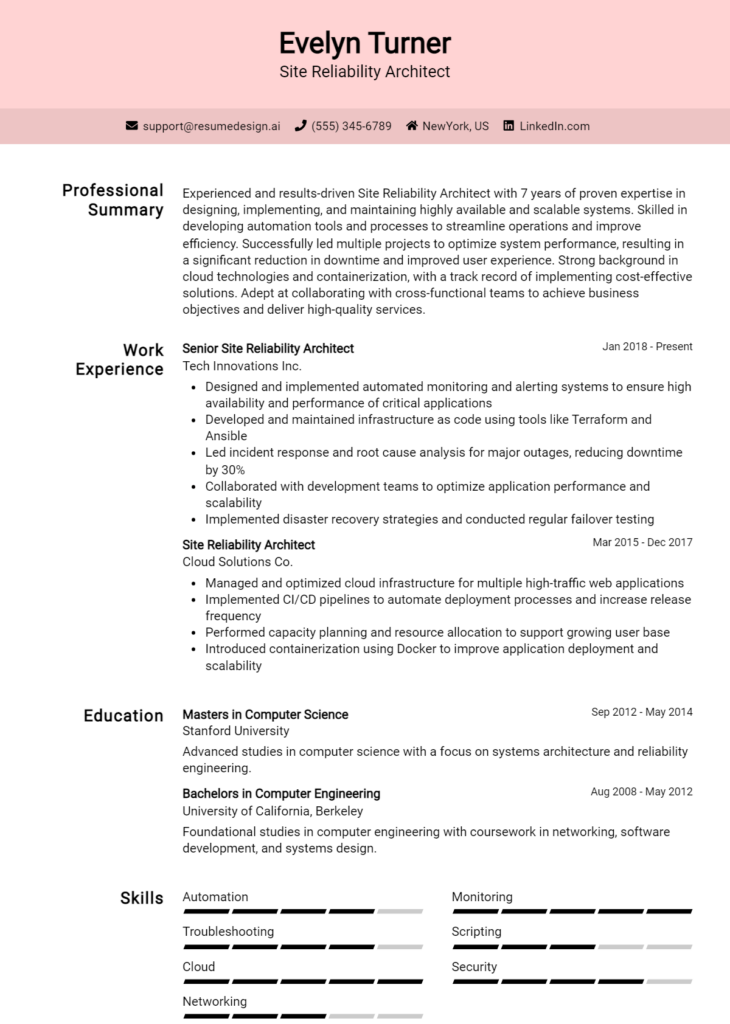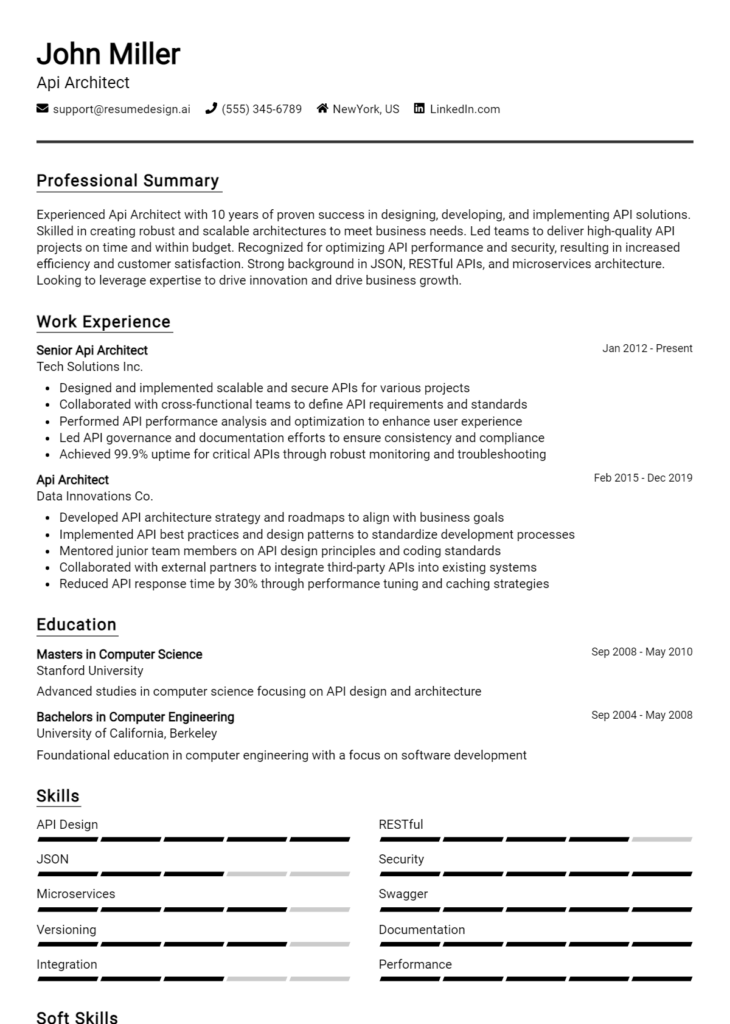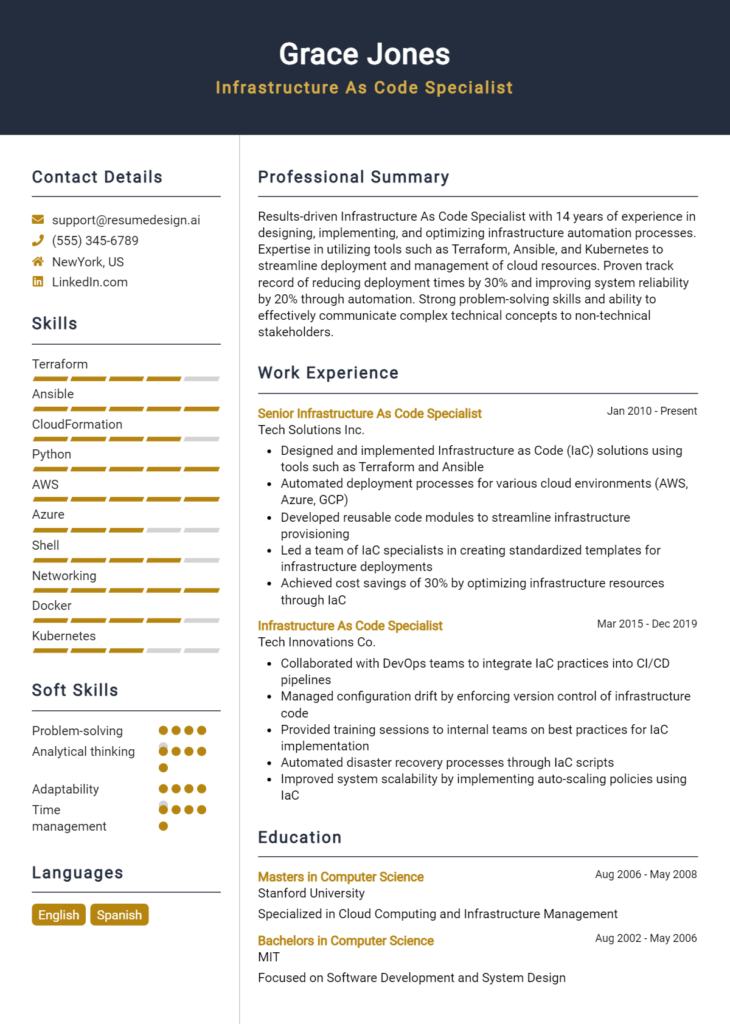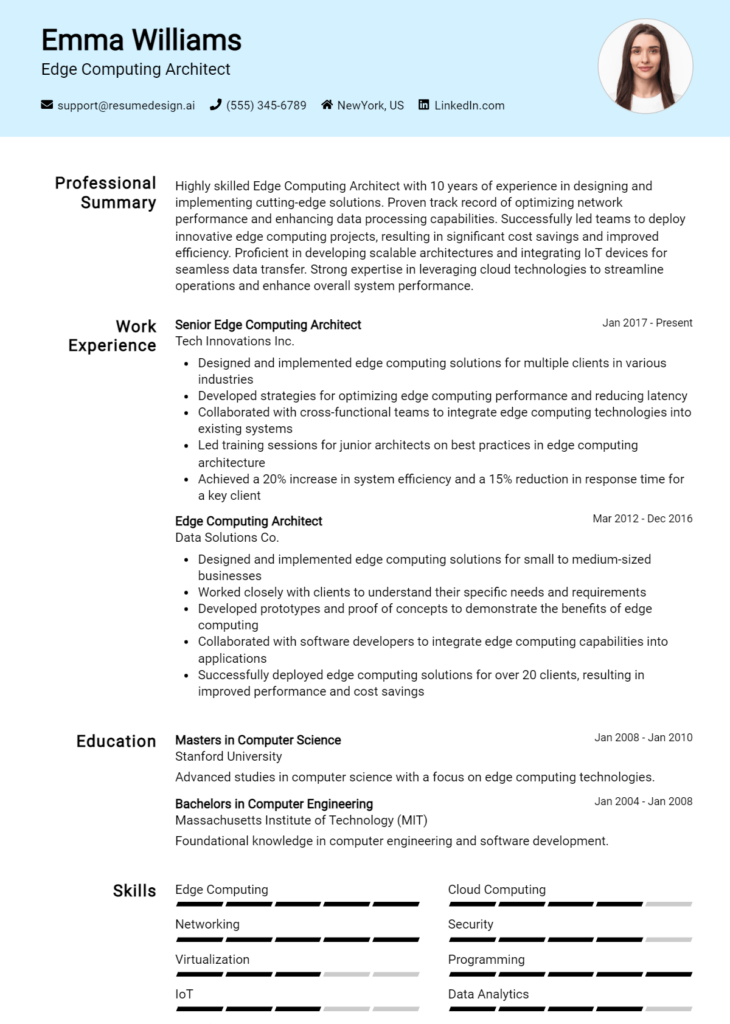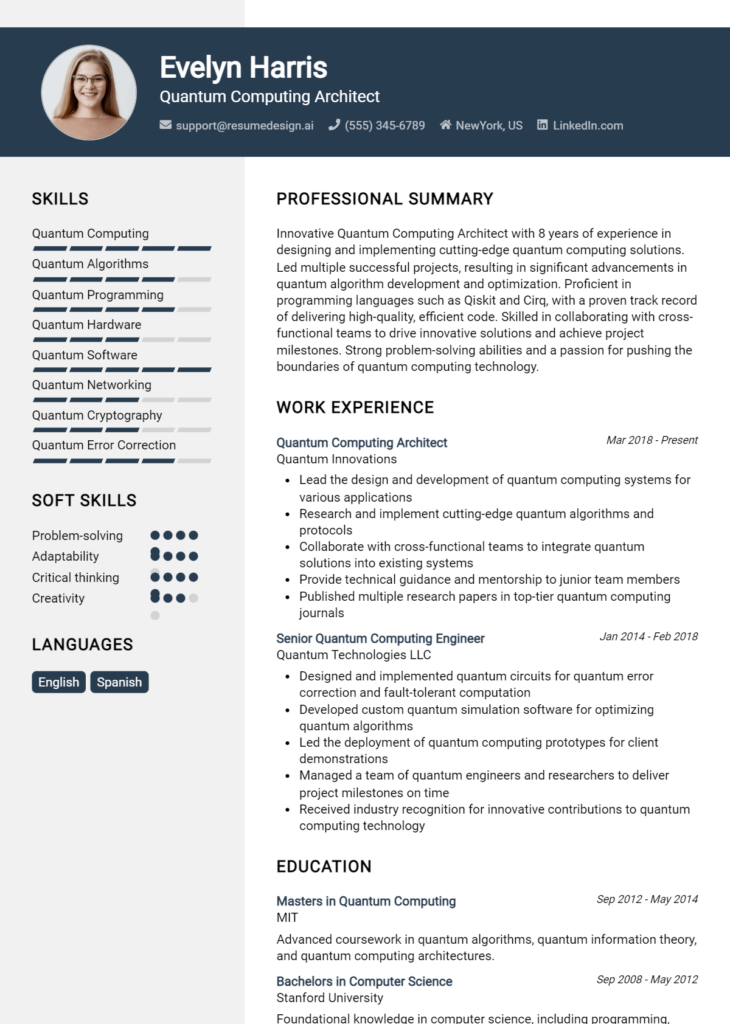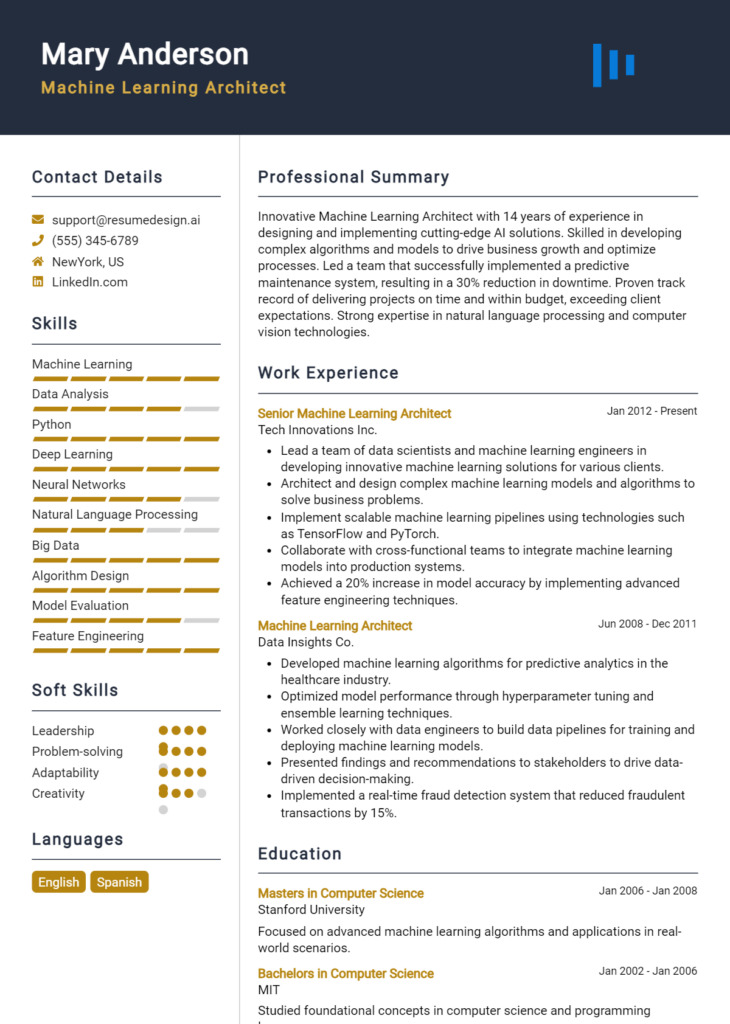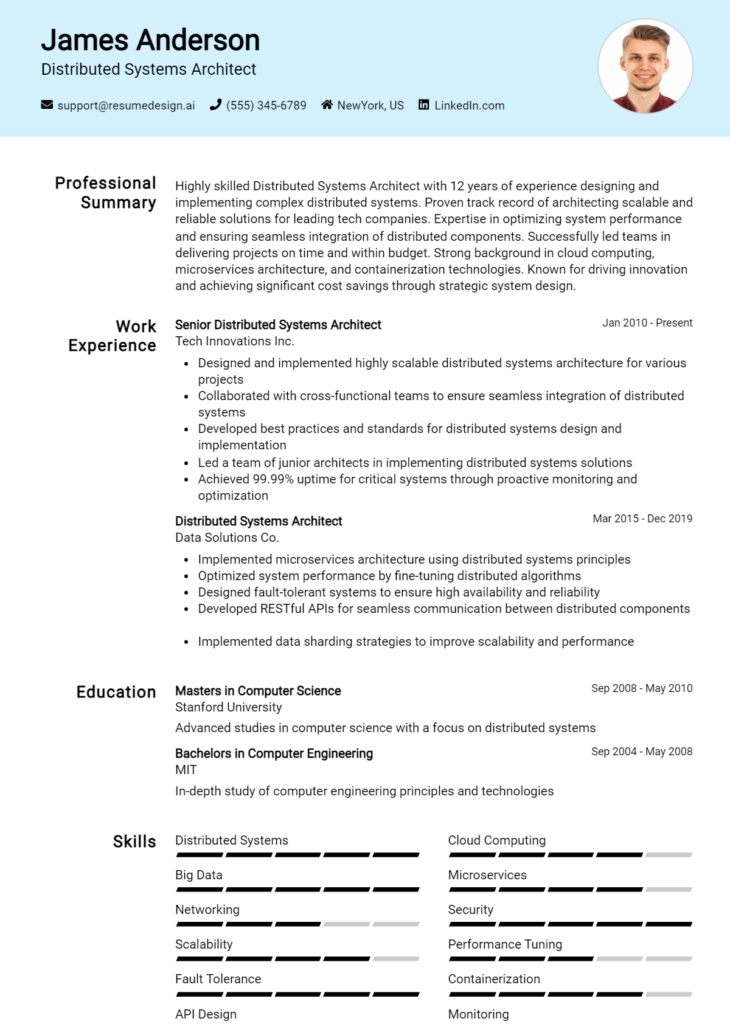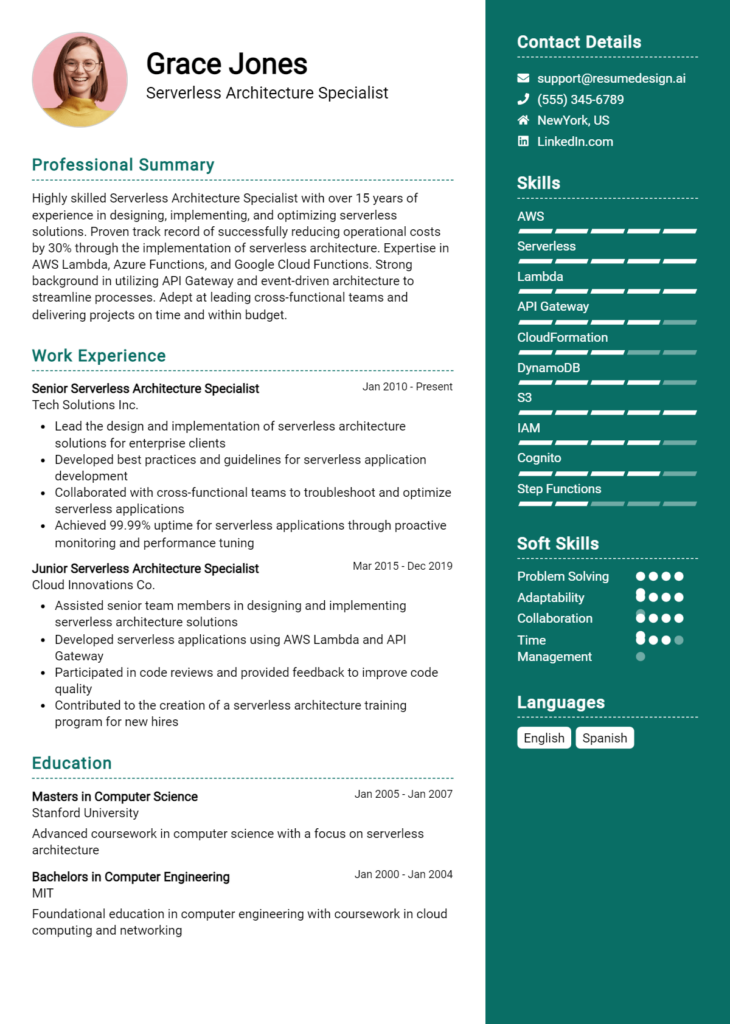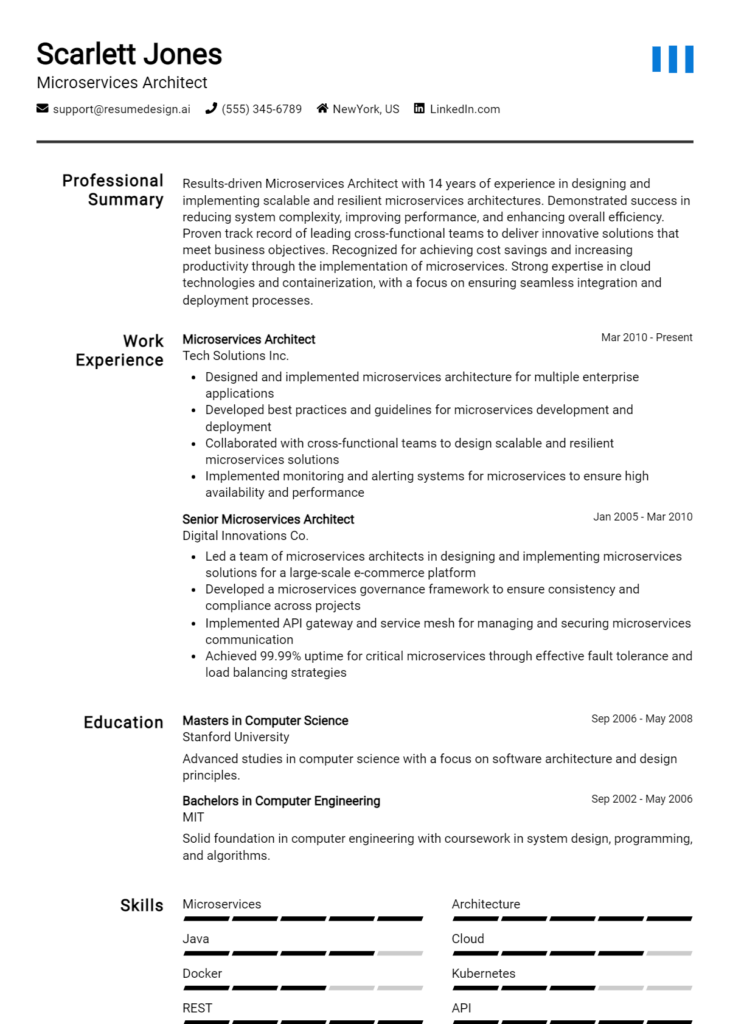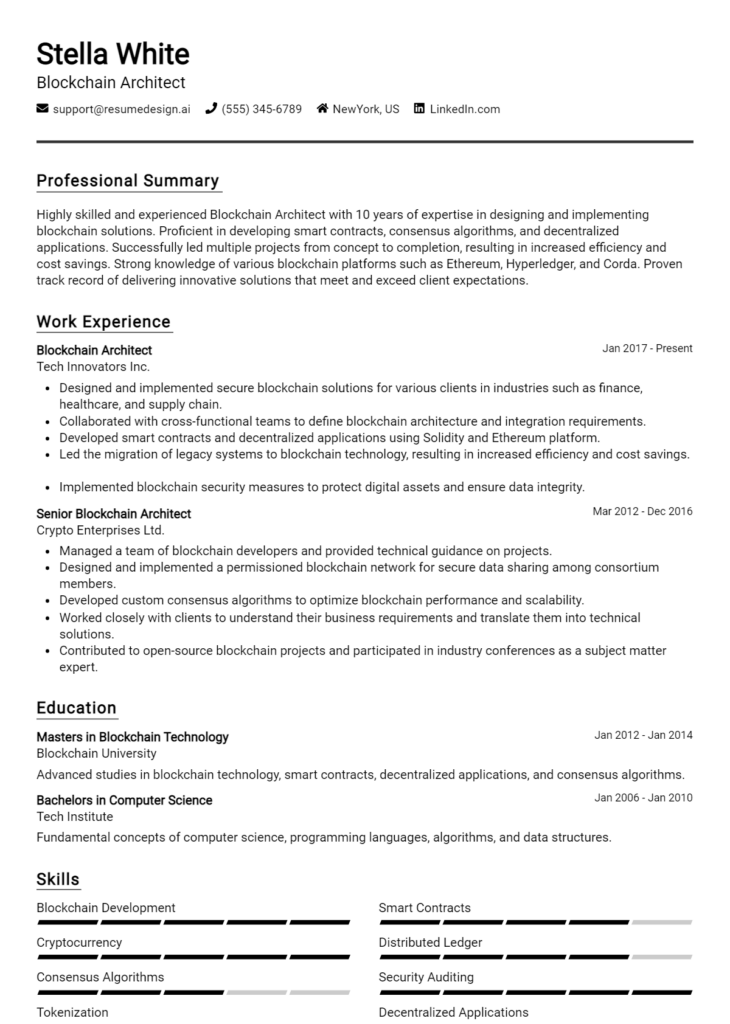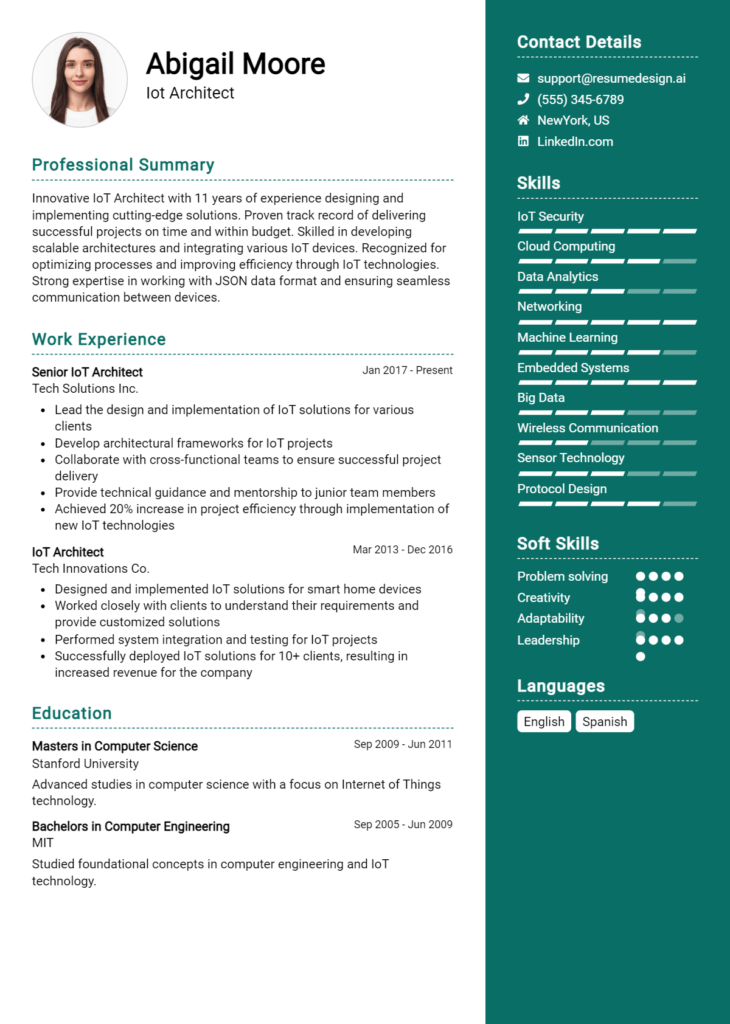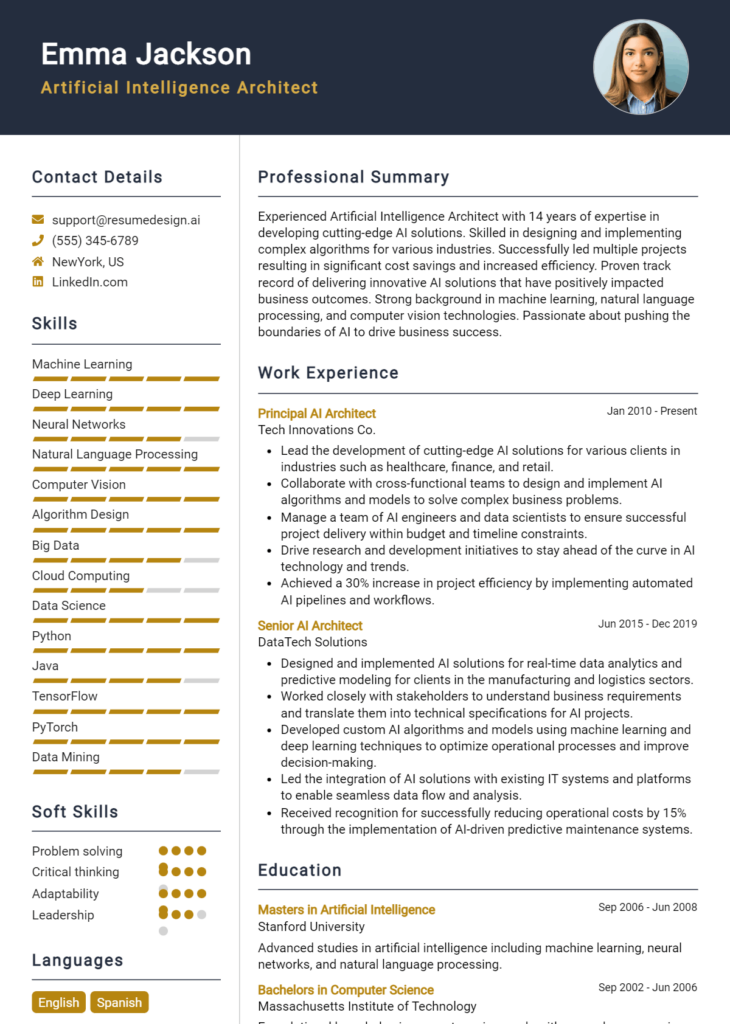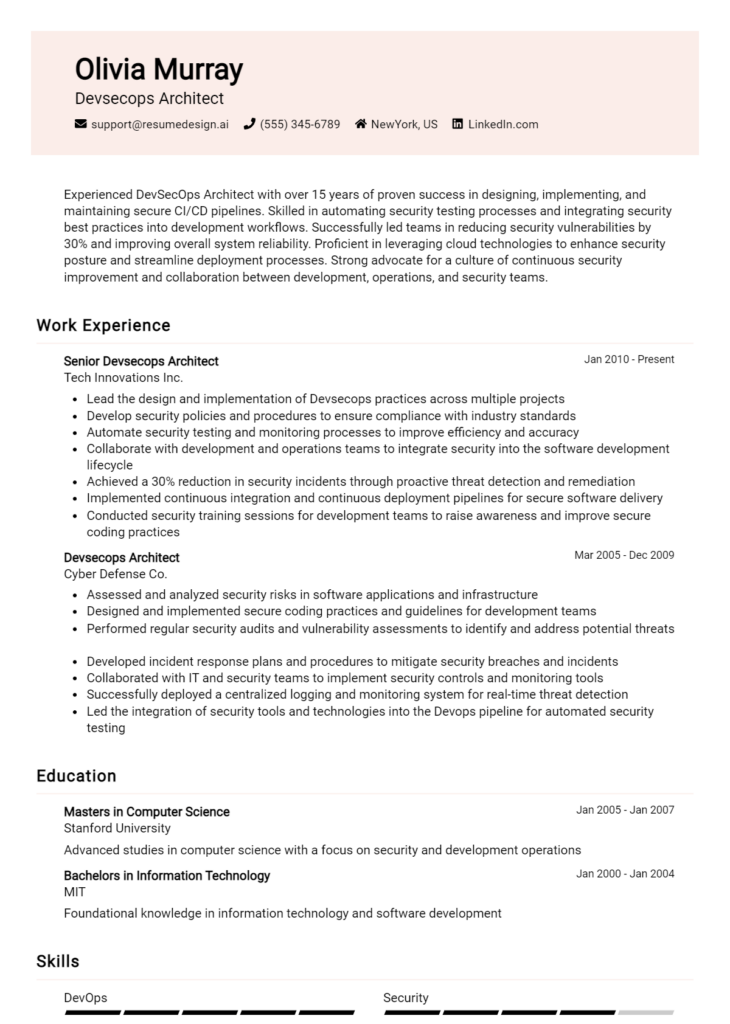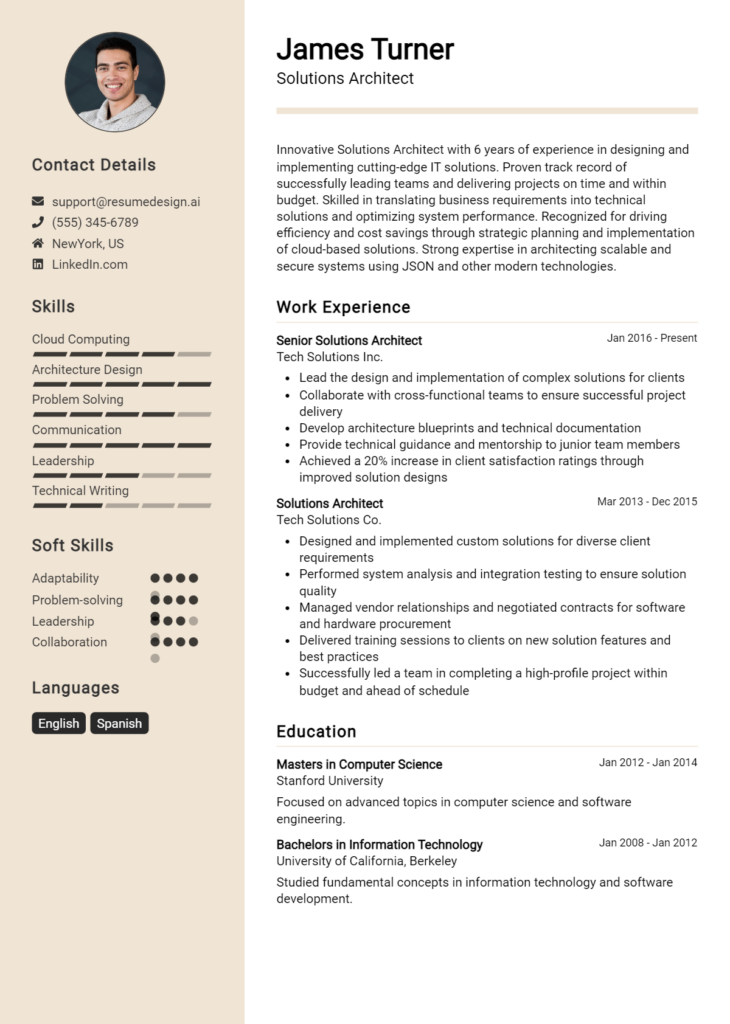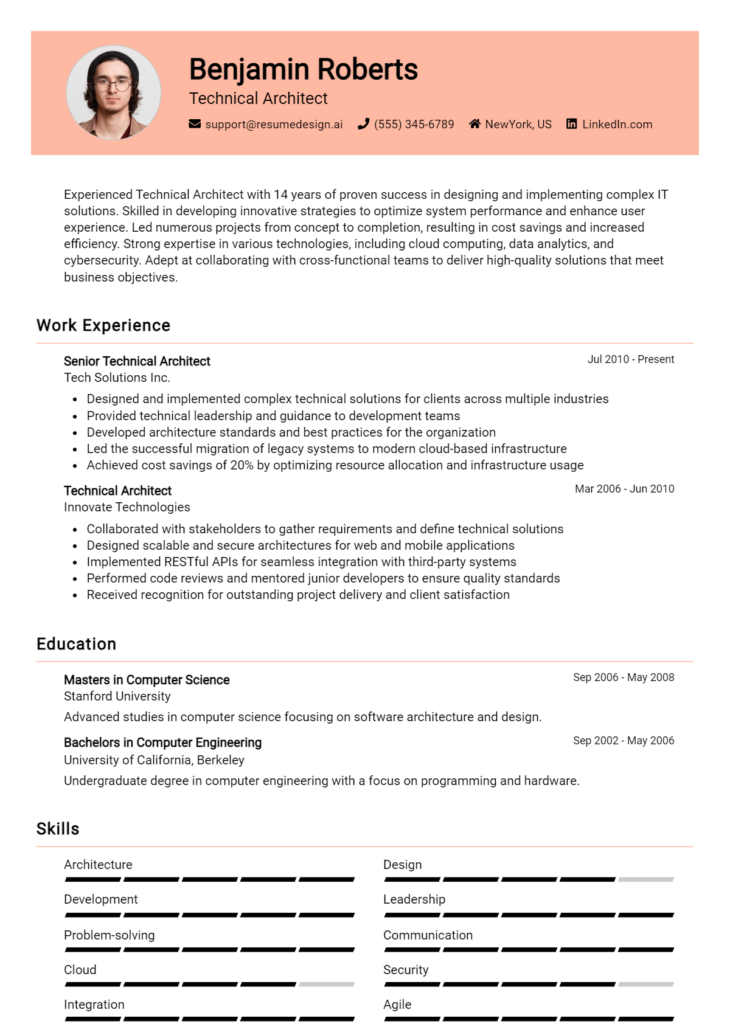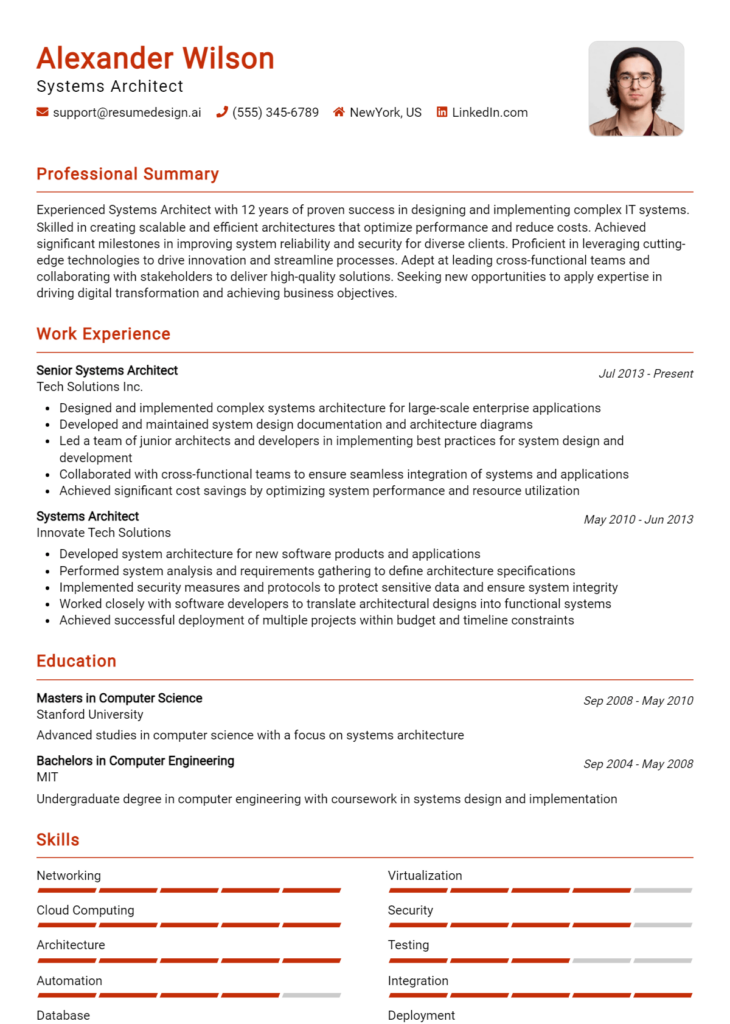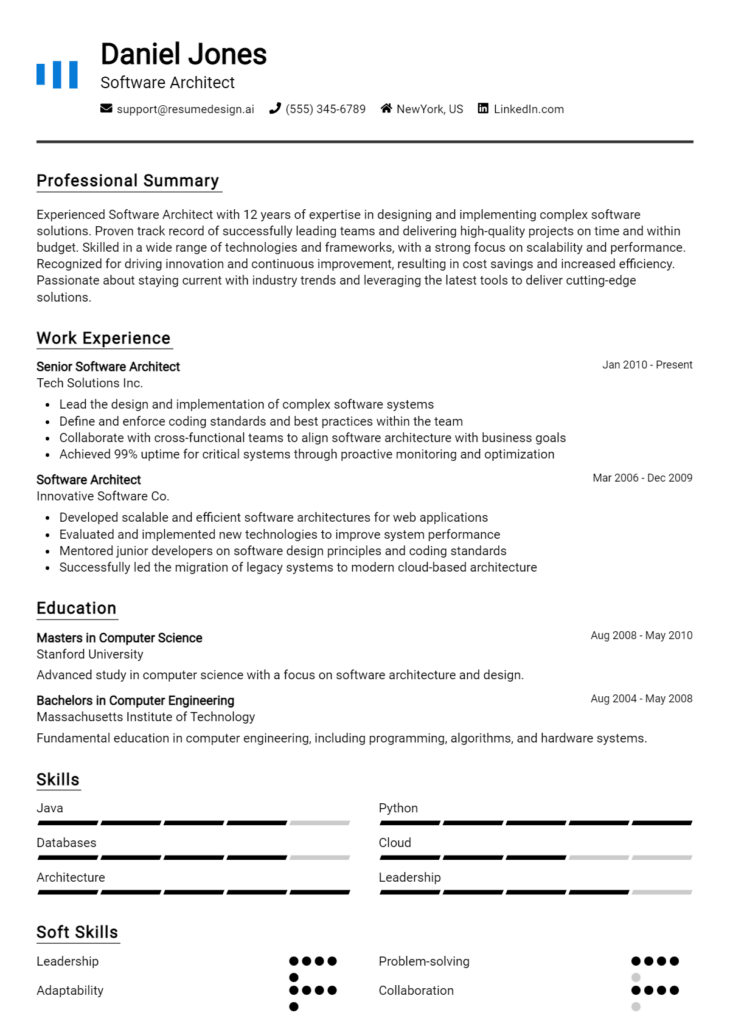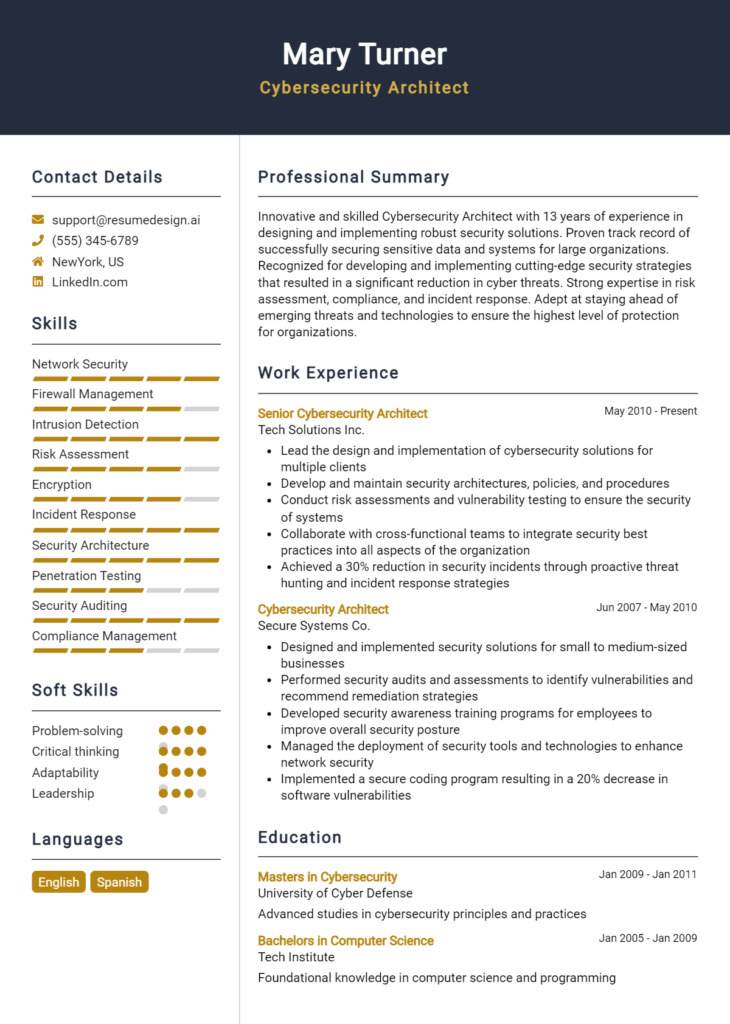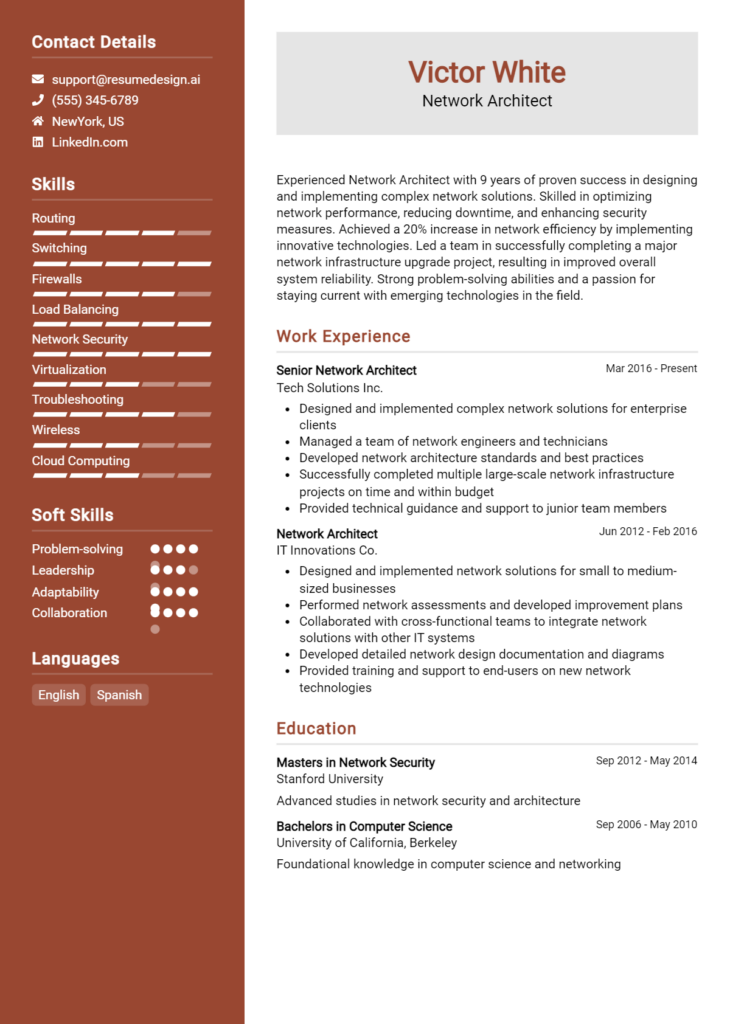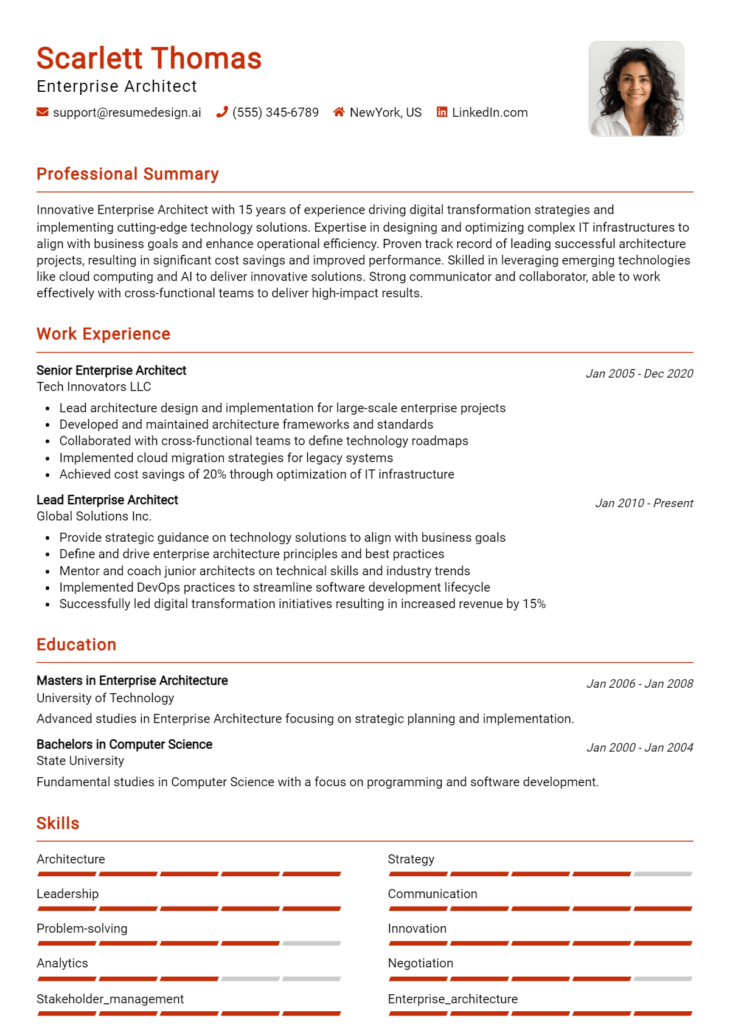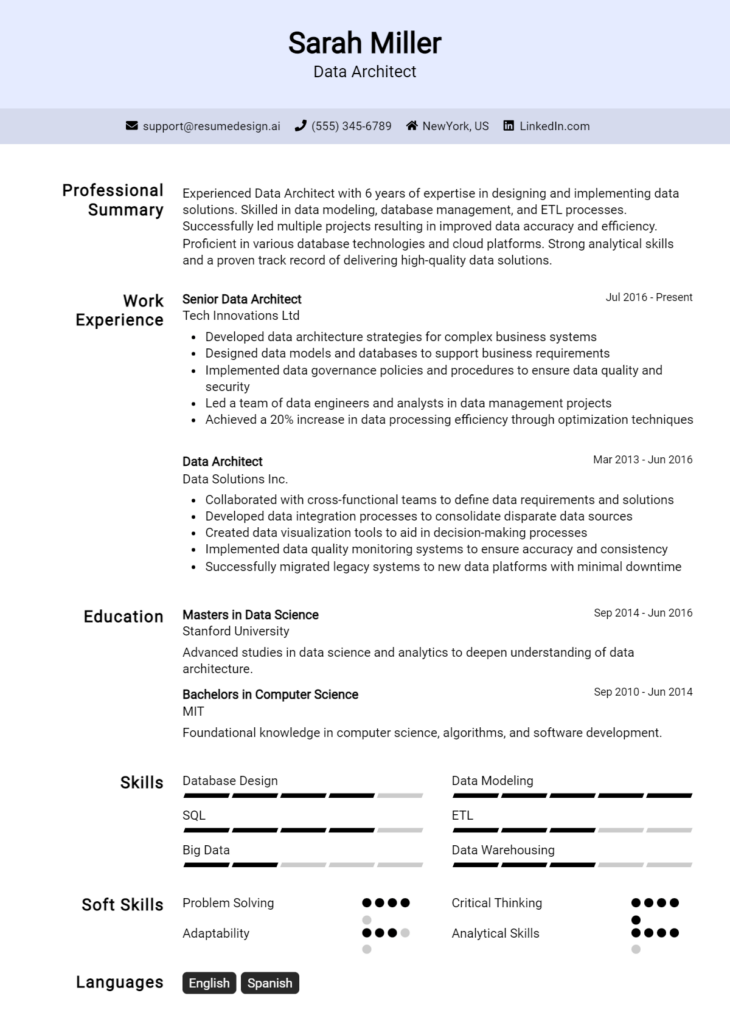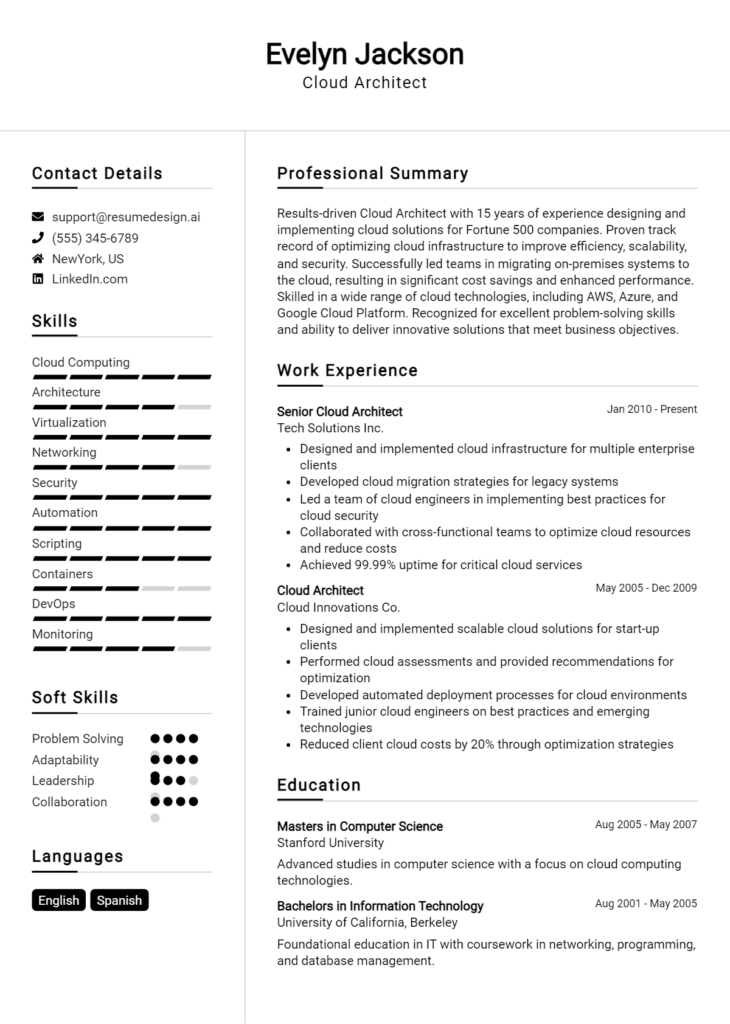Cloud Native Architect Core Responsibilities
A Cloud Native Architect plays a crucial role in designing and implementing cloud-native solutions that align with organizational goals. Key responsibilities include collaborating across departments to ensure seamless integration of cloud services, optimizing system performance, and driving innovation through emerging technologies. Essential skills encompass technical expertise in cloud platforms, operational proficiency in DevOps practices, and strong problem-solving abilities. A well-structured resume showcasing these qualifications can significantly enhance job prospects and highlight the architect's contributions to the organization's success.
Common Responsibilities Listed on Cloud Native Architect Resume
- Design and implement cloud-native architectures that meet business requirements.
- Collaborate with cross-functional teams to define cloud strategy and solutions.
- Optimize application performance and scalability in cloud environments.
- Conduct assessments of existing systems to identify opportunities for migration.
- Develop and enforce best practices for cloud security and compliance.
- Lead DevOps initiatives to streamline CI/CD processes.
- Evaluate and recommend tools and technologies for cloud implementation.
- Provide technical leadership and mentorship to junior team members.
- Document architecture designs and operational procedures.
- Monitor and troubleshoot cloud infrastructure and applications.
- Stay updated on cloud trends and emerging technologies.
- Facilitate training sessions and workshops on cloud principles.
High-Level Resume Tips for Cloud Native Architect Professionals
In today's competitive job market, a well-crafted resume is crucial for Cloud Native Architect professionals looking to make a lasting impression on potential employers. Your resume often serves as the first point of contact between you and the hiring team, making it essential to accurately reflect your skills, achievements, and expertise in the cloud-native landscape. A compelling resume not only showcases your technical abilities but also tells the story of your professional journey, demonstrating how you can add value to the organization. This guide will provide practical and actionable resume tips specifically tailored for Cloud Native Architect professionals to help you stand out in the hiring process.
Top Resume Tips for Cloud Native Architect Professionals
- Tailor your resume to the job description by incorporating relevant keywords and phrases that align with the role's requirements.
- Highlight your experience with cloud platforms such as AWS, Azure, or Google Cloud, emphasizing specific projects and technologies used.
- Quantify your achievements by including metrics that showcase the impact of your work, such as cost savings or performance improvements.
- Showcase your understanding of microservices architecture, containerization, and orchestration tools like Kubernetes in your experience section.
- Include certifications relevant to cloud technologies, such as AWS Certified Solutions Architect or Google Cloud Professional Architect, to validate your expertise.
- Demonstrate your ability to work in agile environments by detailing your experience with DevOps practices and CI/CD pipelines.
- Highlight your soft skills, such as teamwork, communication, and problem-solving, as these are vital in collaborative cloud environments.
- Keep your resume concise, ideally one to two pages in length, focusing on the most pertinent information to the role you're applying for.
- Use clear formatting and bullet points to enhance readability, ensuring hiring managers can quickly scan your qualifications.
- Include a summary statement at the top of your resume that encapsulates your professional identity and career goals in the cloud-native space.
By implementing these tips, Cloud Native Architect professionals can significantly increase their chances of landing a job in this dynamic field. A resume that effectively showcases your skills, experience, and achievements will not only attract the attention of hiring managers but also set you apart as a top candidate in the competitive cloud-native market.
Why Resume Headlines & Titles are Important for Cloud Native Architect
In the competitive field of cloud computing, the role of a Cloud Native Architect is pivotal for organizations looking to leverage the full potential of cloud technologies. A well-crafted resume headline or title is essential as it serves as the first impression a hiring manager will have of a candidate. A strong headline can immediately capture attention, succinctly summarize the candidate's key qualifications, and set the tone for the rest of the resume. It should be concise, relevant, and directly aligned with the job being applied for, providing a snapshot of what the candidate brings to the table in the realm of cloud architecture.
Best Practices for Crafting Resume Headlines for Cloud Native Architect
- Keep it concise: Aim for a headline that is no longer than 10 words.
- Be role-specific: Include specific terms that relate directly to cloud architecture.
- Highlight key skills: Mention essential skills, such as microservices, container orchestration, or DevOps.
- Use industry keywords: Incorporate relevant keywords that align with the job description.
- Focus on impact: Indicate how your skills can benefit the organization.
- Showcase experience: Reference years of experience or notable projects where applicable.
- Avoid jargon: Use clear language that is easily understood by all hiring managers.
- Tailor for each application: Customize your headline for each job application to reflect the specific role.
Example Resume Headlines for Cloud Native Architect
Strong Resume Headlines
"Certified Cloud Native Architect with 7+ Years of Experience in Microservices Development"
“Expert in Kubernetes and Containerization Solutions for Scalable Applications”
“Cloud Solutions Architect with Proven Track Record in Cost Optimization and Performance Improvement”
Weak Resume Headlines
“Experienced IT Professional”
“Cloud Architect”
The strong headlines are effective because they are specific, showcasing relevant skills and experience, which immediately conveys the value the candidate can bring to a potential employer. They utilize industry-specific language and metrics that resonate with hiring managers looking for particular qualifications. In contrast, the weak headlines fail to impress due to their vagueness and lack of detail, leaving hiring managers with little information to gauge the candidate's suitability for the role. By avoiding generic titles, candidates can better position themselves as qualified and relevant for the Cloud Native Architect position.
Writing an Exceptional Cloud Native Architect Resume Summary
A well-crafted resume summary is a vital component for a Cloud Native Architect, serving as the first impression for hiring managers who sift through numerous applications. This brief but powerful statement succinctly encapsulates your key skills, relevant experience, and noteworthy accomplishments in cloud-native technologies. An impactful summary not only captures attention but also establishes your qualifications, showcasing how you can bring value to the prospective employer. It should be concise, yet detailed enough to convey your fit for the specific role, ensuring that it resonates with the job description and requirements outlined by the company.
Best Practices for Writing a Cloud Native Architect Resume Summary
- Quantify Achievements: Use specific numbers and outcomes to demonstrate your impact in previous roles.
- Focus on Relevant Skills: Highlight technical skills and expertise that align closely with the job description.
- Tailor for the Job: Customize your summary for each application to reflect the specific requirements and values of the employer.
- Keep it Concise: Aim for 3-5 sentences that succinctly convey your qualifications without unnecessary fluff.
- Use Action-Oriented Language: Start with strong action verbs to convey your contributions effectively.
- Showcase Certifications: Include relevant certifications that validate your expertise in cloud technologies.
- Highlight Leadership Roles: If applicable, mention any leadership or team-building experience that demonstrates your capability to guide projects.
- Incorporate Industry Keywords: Utilize keywords from the job listing to improve your chances of passing through Applicant Tracking Systems (ATS).
Example Cloud Native Architect Resume Summaries
Strong Resume Summaries
Dynamic Cloud Native Architect with over 10 years of experience in designing and implementing scalable cloud solutions. Successfully migrated over 50 applications to AWS, achieving a 30% reduction in infrastructure costs while improving system performance by 40%.
Results-driven Cloud Native Architect specializing in microservices architecture and container orchestration. Led a team to develop a cloud-native application that increased customer engagement by 25% and reduced deployment time from weeks to hours.
Certified Cloud Solutions Architect with a proven track record of optimizing cloud environments for Fortune 500 companies. Delivered a multi-cloud strategy that reduced operational costs by 20%, enhancing overall system reliability and performance.
Weak Resume Summaries
Experienced IT professional with knowledge of cloud technologies looking for a new opportunity.
Cloud Native Architect with some experience in cloud projects and a desire to learn more.
The examples of strong resume summaries are considered effective due to their specific quantifiable achievements, relevant skills, and direct alignment with the Cloud Native Architect role. They showcase the candidate's impact and abilities in clear terms. Conversely, the weak summaries are vague and lack detail, failing to provide any measurable outcomes or compelling reasons for hiring managers to consider the candidate for the position.
Work Experience Section for Cloud Native Architect Resume
The work experience section of a Cloud Native Architect resume plays a crucial role in demonstrating the candidate's technical skills, leadership capabilities, and track record of delivering high-quality products. This section not only highlights the individual's hands-on experience with cloud technologies but also showcases their ability to manage teams effectively and drive collaborative efforts toward successful project outcomes. By quantifying achievements and aligning their experience with industry standards, candidates can effectively portray their value to potential employers, making this section a pivotal part of the overall resume.
Best Practices for Cloud Native Architect Work Experience
- Use specific metrics to quantify achievements, such as percentage improvements in system performance or cost reductions.
- Highlight technical expertise by detailing specific cloud platforms, tools, and technologies utilized in past roles.
- Emphasize leadership and team management experience, including the size of teams led and the impact of projects overseen.
- Include examples of successful collaboration with cross-functional teams, demonstrating communication and teamwork skills.
- Focus on relevant industry standards and practices, ensuring alignment with current trends in cloud architecture.
- Tailor the work experience section to reflect job descriptions of targeted positions, highlighting relevant experiences.
- Showcase innovative solutions or processes developed that led to improved efficiency or productivity.
- Incorporate feedback or recognition received from stakeholders or clients to reinforce the impact of your contributions.
Example Work Experiences for Cloud Native Architect
Strong Experiences
- Led a team of 10 engineers in the migration of a legacy system to a cloud-native architecture, resulting in a 40% reduction in operational costs and a 50% improvement in deployment speed.
- Designed and implemented a microservices architecture that supported a 200% increase in user traffic while maintaining 99.99% uptime over a 12-month period.
- Collaborated with cross-functional teams to develop a cloud security framework that reduced vulnerabilities by 60%, leading to enhanced compliance with industry regulations.
- Introduced CI/CD pipelines that decreased software release cycles from bi-weekly to daily, enabling faster delivery of features and updates to clients.
Weak Experiences
- Worked on cloud projects which involved various technologies.
- Participated in team meetings and provided input on cloud strategies.
- Helped with some aspects of cloud migration.
- Supported multiple projects in a cloud environment.
The examples listed as strong experiences are considered effective because they provide clear, quantifiable outcomes that demonstrate the candidate's impact on previous projects. They specify technical leadership roles and highlight collaboration with measurable results. In contrast, the weak experiences lack detail and specific achievements, making them less compelling and failing to show how the candidate contributed meaningfully to their roles.
Education and Certifications Section for Cloud Native Architect Resume
The education and certifications section of a Cloud Native Architect resume plays a critical role in showcasing a candidate's academic background and professional qualifications. This section not only highlights the formal education that provides a foundational understanding of cloud computing and architecture, but it also emphasizes industry-relevant certifications that demonstrate a commitment to continuous learning and expertise in emerging technologies. By providing details on relevant coursework, certifications, and specialized training, candidates can significantly enhance their credibility and align themselves with the specific requirements of the Cloud Native Architect role, making a compelling case for their candidacy.
Best Practices for Cloud Native Architect Education and Certifications
- Focus on relevant degrees such as Computer Science, Information Technology, or Software Engineering.
- Include certifications from recognized organizations, like AWS Certified Solutions Architect or Google Professional Cloud Architect.
- Highlight any specialized training in cloud-native technologies, microservices, or container orchestration tools.
- Provide details on relevant coursework that pertains to cloud architecture and design patterns.
- Keep certifications up to date and mention recertification efforts to demonstrate ongoing professional development.
- List any participation in relevant workshops, conferences, or webinars that add value to your expertise.
- Use clear formatting to make it easy for hiring managers to quickly identify your qualifications.
- Consider including online courses or bootcamps focused on cloud-native technologies that supplement formal education.
Example Education and Certifications for Cloud Native Architect
Strong Examples
- Bachelor of Science in Computer Science, XYZ University, 2020
- AWS Certified Solutions Architect – Professional, 2022
- Certified Kubernetes Administrator (CKA), 2023
- Relevant Coursework: Cloud Computing, Distributed Systems, Microservices Architecture
Weak Examples
- Associate Degree in Graphic Design, ABC College, 2018
- Microsoft Certified Professional (outdated certification), 2017
- Certification in Java Programming, 2015 (not relevant to cloud architecture)
- Relevant Coursework: Introduction to Art History
The examples provided highlight a clear distinction between strong and weak qualifications. Strong examples reflect relevant degrees, up-to-date certifications, and applicable coursework that align with the Cloud Native Architect role, demonstrating the candidate's capacity for the job. Conversely, weak examples showcase outdated or irrelevant education and certifications that do not contribute to the candidate's qualifications for a cloud-native architecture position, ultimately detracting from their overall appeal in the competitive job market.
Top Skills & Keywords for Cloud Native Architect Resume
As the demand for cloud-native solutions continues to grow, the role of a Cloud Native Architect has become increasingly vital in modern IT environments. A well-crafted resume for this position must highlight a blend of technical expertise and interpersonal abilities, showcasing the candidate's capability to design, implement, and manage cloud-native architectures effectively. Key skills not only demonstrate proficiency but also reflect a candidate’s ability to collaborate across teams, navigate complex challenges, and drive innovation. Including the right skills in your resume can make a significant difference in attracting the attention of potential employers, and it's essential to tailor your skills to align with the specific requirements of the job you are applying for. For a deeper understanding of essential skills and how to articulate your work experience, it’s beneficial to explore relevant resources.
Top Hard & Soft Skills for Cloud Native Architect
Soft Skills
- Strong communication skills
- Team collaboration
- Problem-solving mindset
- Adaptability to change
- Critical thinking
- Leadership abilities
- Conflict resolution
- Time management
- Attention to detail
- Client-focused mindset
Hard Skills
- Proficiency in cloud platforms (AWS, Azure, Google Cloud)
- Container orchestration (Kubernetes, Docker)
- Microservices architecture
- Infrastructure as Code (IaC) with tools like Terraform
- Continuous Integration/Continuous Deployment (CI/CD) pipelines
- API design and management
- DevOps practices
- Security best practices in cloud architecture
- Monitoring and logging tools (Prometheus, ELK stack)
- Database management and design (SQL, NoSQL)
Stand Out with a Winning Cloud Native Architect Cover Letter
I am excited to apply for the Cloud Native Architect position at [Company Name], as advertised on [Job Board/Company Website]. With over [X years] of experience in cloud computing and a robust understanding of microservices architecture, I am well-equipped to help [Company Name] continue its journey towards innovative and scalable cloud solutions. My background in designing and implementing cloud-native applications has honed my skills in leveraging modern technologies like Kubernetes, Docker, and serverless computing to optimize performance and reduce operational costs.
Throughout my career, I have successfully led cross-functional teams in migrating legacy systems to cloud environments, resulting in increased efficiency and reduced time to market for new product features. At [Previous Company Name], I spearheaded a project that transitioned monolithic applications to a microservices architecture, which improved system resilience and scalability. My expertise in cloud platforms such as AWS, Azure, and Google Cloud allows me to tailor solutions that best fit the unique needs of each project, ensuring seamless integration and exceptional user experience.
Moreover, I am passionate about advocating for best practices in cloud architecture and DevOps methodologies. I thrive in collaborative environments and enjoy mentoring colleagues to foster a culture of continuous improvement and innovation. I am eager to bring my skills in automation, container orchestration, and cloud security to [Company Name], ensuring that we not only meet but exceed client expectations through state-of-the-art cloud solutions.
I am looking forward to the opportunity to discuss how my experience and vision align with the goals of [Company Name]. Thank you for considering my application. I am excited about the possibility of contributing to your team and helping drive the success of your cloud initiatives. Please feel free to contact me at [Your Phone Number] or [Your Email] to arrange a conversation.
Common Mistakes to Avoid in a Cloud Native Architect Resume
Crafting a compelling resume as a Cloud Native Architect is crucial to standing out in a competitive job market. However, many candidates make common mistakes that can hinder their chances of landing an interview. By avoiding these pitfalls, you can present a clearer picture of your qualifications and experiences, showcasing your unique skills in cloud architecture. Here are some prevalent mistakes to watch out for:
Vague Job Descriptions: Using generic terms instead of specific responsibilities can make it difficult for employers to understand your role in previous projects.
Neglecting Soft Skills: While technical skills are essential, overlooking the importance of soft skills like communication and teamwork can diminish your appeal as a collaborative architect.
Lack of Quantifiable Achievements: Failing to include metrics or outcomes related to your projects can leave hiring managers questioning the impact of your contributions.
Ignoring Cloud Service Providers: Not mentioning your experience with popular cloud platforms (like AWS, Azure, or Google Cloud) can make your resume less relevant to the job.
Overloading with Jargon: Using excessive technical jargon without context can alienate non-technical recruiters who may be reviewing your resume.
Inconsistent Formatting: A cluttered or inconsistent format can distract from the content of your resume and make it harder to read.
Ignoring Project Relevance: Including unrelated work experiences can dilute your focus; ensure that your projects and roles are pertinent to cloud architecture.
Failing to Tailor the Resume: Sending out a generic resume without adapting it to the specific job description can result in missed opportunities, as each position may require different skills and experiences.
Conclusion
As we conclude our exploration of the Cloud Native Architect role, it's clear that this position is vital for organizations looking to leverage the full potential of cloud technologies. We highlighted the essential skills required, including expertise in microservices architecture, container orchestration, and cloud infrastructure management. Additionally, we discussed the importance of staying updated with industry trends and best practices to effectively design and implement cloud-native solutions.
In light of this, it’s crucial for aspiring and current Cloud Native Architects to have an impactful resume that showcases their skills and experiences. To help you craft an impressive resume, consider utilizing the following resources:
- Check out resume templates that can provide a professional layout for your information.
- Use the resume builder to create a tailored resume quickly and efficiently.
- Explore resume examples for inspiration and guidance on structuring your accomplishments.
- Don’t forget to enhance your application with a compelling cover letter using our cover letter templates.
Take action now to review and update your Cloud Native Architect resume, ensuring it reflects your qualifications and sets you apart in this competitive field.


